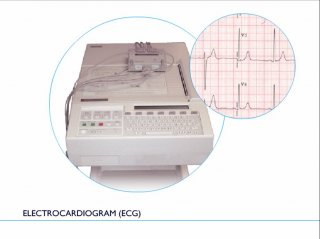ECG
The ECG or electrocardiogram is a test that measures the electrical activity of the heart. It is one of the basic investigations used by heart specialists to determine the heart rate, rhythm and function.
An ECG is sometimes called a 12-lead ECG because the electrical activity of the heart is most often displayed from 12 different postions, measured or calculated from 10 leads attached to the patient. It is a simple test that detects and records the electrical activity of the heart as it is transmitted to the patient's skin.
Electrical signals in the heart trigger heartbeats. These signals start at the top of the heart in an area called the right atrium. The electrical signals travel from the top of the heart to the bottom. They cause the heart muscle to contract as they travel through the heart. As the heart contracts, it pumps blood to the lungs and the rest of the body.
Each heartbeat generates a signal or ECG complex that shows how the heart's electrical circuit is working. This complex also changes when the blood and oxygen supply to the heart are impaired, and for this reason the ECG is the main test used for diagnosing heart attacks (myocardial infarction). The complexes can also indicate whether their is strain or overgrowth (hypertrophy) of the heart muscle.
The frequency of the complex shows the heart rate. Normal heart rhythm (sinus rhythm) and abnormal heart rhythms can also be detected.The abnormal rhythms may lead to fast regular or fast irregular heart beats which may cause palpitations. In some patients the normal electrical circuitry of the heart is interrupted leading to a slow, sometimes unreliable, heart rhythm. Such heart block may require the implantation of a permanent pacemaker device to scure the heart rhythm and prevent blackouts or death.
An ECG is a painless, harmless test that can be performed by a cardiac technician, nurse or doctor to provide useful diagnostic information.
